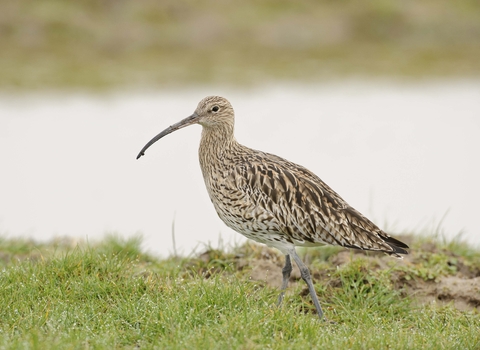
Curlew ©Terry Whittaker/2020VISION
Curlew
Scientific name
Numenius arquataWhen to see
January to DecemberSpecies information
Category
Statistics
Length: 50-60cmWingspan: 90cm
Weight: 770g-1kg
Average lifespan: 5 years
About
The curlew is a very large, tall wader, about the same size as a female pheasant. Its haunting display call ('cur-lee') is unmistakable and can be heard from February through to July on its breeding grounds - wet grasslands, farmland, heath and moorlands. From July onwards, coastal numbers start to build up, peaking in January.How to identify
Curlew are mottled brown and grey, with long, bluish legs and a long, downcurved bill that is pink underneath. It can be distinguished from the smaller whimbrel by the longer bill and plain head pattern. When they fly, curlew have a white wedge on the rump.Distribution
A breeding bird of wet grasslands and moorlands in northern England, Wales and Scotland. Common on migration at wetlands throughout the country. Winters around the coast.In our area
Once common in Shropshire, Curlew numbers have declined by 77% in 20 years.
However, work is being done to try and reverse this decline by helping curlews when they nest, to give chicks a better chance of fledging and to influence conservation measures. This is being coordinated by Curlew Country, Shropshire Ornithological Society and volunteers involved with Wildlife Community Groups.
Why are they disappearing?
There are a number of reasons: habitat changes such as a loss of wet grassland and intensive farming have had an impact on curlews across the UK. But even in environment-friendly rural property, increasing numbers of predators are also impacting breeding success. Much work is being done to fence off nest sites, to reduce the chance of them being predated.
Recently, Curlew have been spotted at Wood Lane Nature Reserve.
Watch the Curlew County web cam footage by clicking here.
Did you know?
An old Scottish name for the curlew is 'whaup' or 'great whaup'. Its evocative call has been immortalised in the poem, The Seafarer, which dates back to 1,000 AD, but may be even older: "I take my gladness in the... sound of the curlew instead of the laughter of men".Watch
Curlew (https://vimeo.com/444189244)
Curlew by Nicola S
Once common in Shropshire, Curlew numbers have declined by 77% in 20 years.
However, work is being done to try and reverse this decline by helping curlews when they nest, to give chicks a better chance of fledging and to influence conservation measures. This is being coordinated by Curlew Country, Shropshire Ornithological Society and volunteers involved with Wildlife Community Groups.
Why are they disappearing?
There are a number of reasons: habitat changes such as a loss of wet grassland and intensive farming have had an impact on curlews across the UK. But even in environment-friendly rural property, increasing numbers of predators are also impacting breeding success. Much work is being done to fence off nest sites, to reduce the chance of them being predated.
Recently, Curlew have been spotted at Wood Lane Nature Reserve.
Watch the Curlew County web cam footage by clicking here.

